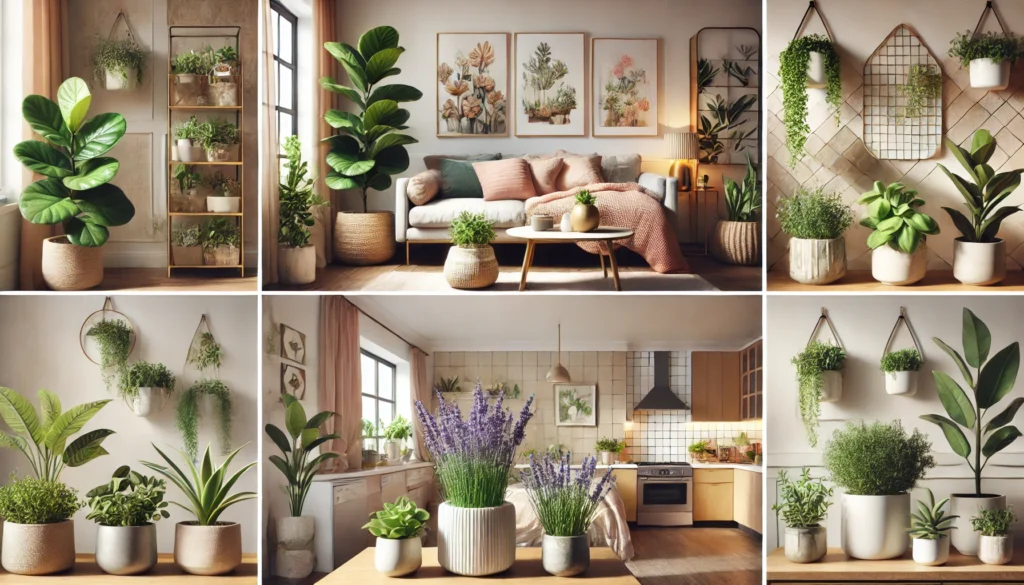
Choosing the Right Plant for Each Room: Tips for Perfect Indoor Greenery
Have you ever wondered how the right indoor plants can completely transform a room? From purifying the air to adding a touch of nature, plants can elevate any space. However, choosing the right plant for each room isn’t always as simple as picking your favorite greenery. Whether it’s the lighting conditions, humidity, or space available, there are several factors to consider. In this article, we’ll guide you through the process of choosing the right plant for each room, ensuring that your plants thrive while enhancing the beauty of your home.
Table of Contents
ToggleUnderstanding Room Factors Before Choosing a Plant 🌿
Before you start picking out plants, it’s essential to understand the specific conditions of each room. By doing so, you’ll ensure your plants thrive and look their best. Let’s dive into the key factors you need to consider when choosing the right plant for each room:
Lighting 🌞
Plants rely on the amount of light they receive to grow. The right light is crucial for healthy plants!
- Bright light: Rooms with plenty of direct sunlight (like south-facing windows) are perfect for plants like succulents 🪴, cacti 🌵, and fiddle leaf figs.
- Medium light: If the room gets indirect light, try plants like snake plants or peace lilies 🌸.
- Low light: For rooms with little sunlight, choose plants that can handle shade, such as ZZ plants or pothos 🍃.
Temperature & Humidity 🌡️💧
Temperature and humidity levels vary from room to room, which can affect plant health.
- Dry rooms: Succulents, cacti, and air plants 🌵 thrive in dry, low-humidity environments like living rooms or offices.
- Humid areas: Bathrooms and kitchens are often more humid, perfect for plants like ferns 🌿, peace lilies, and pothos.
- Cool rooms: Avoid placing tropical plants in cold rooms. Instead, choose plants like calatheas or spider plants that tolerate cooler temperatures.
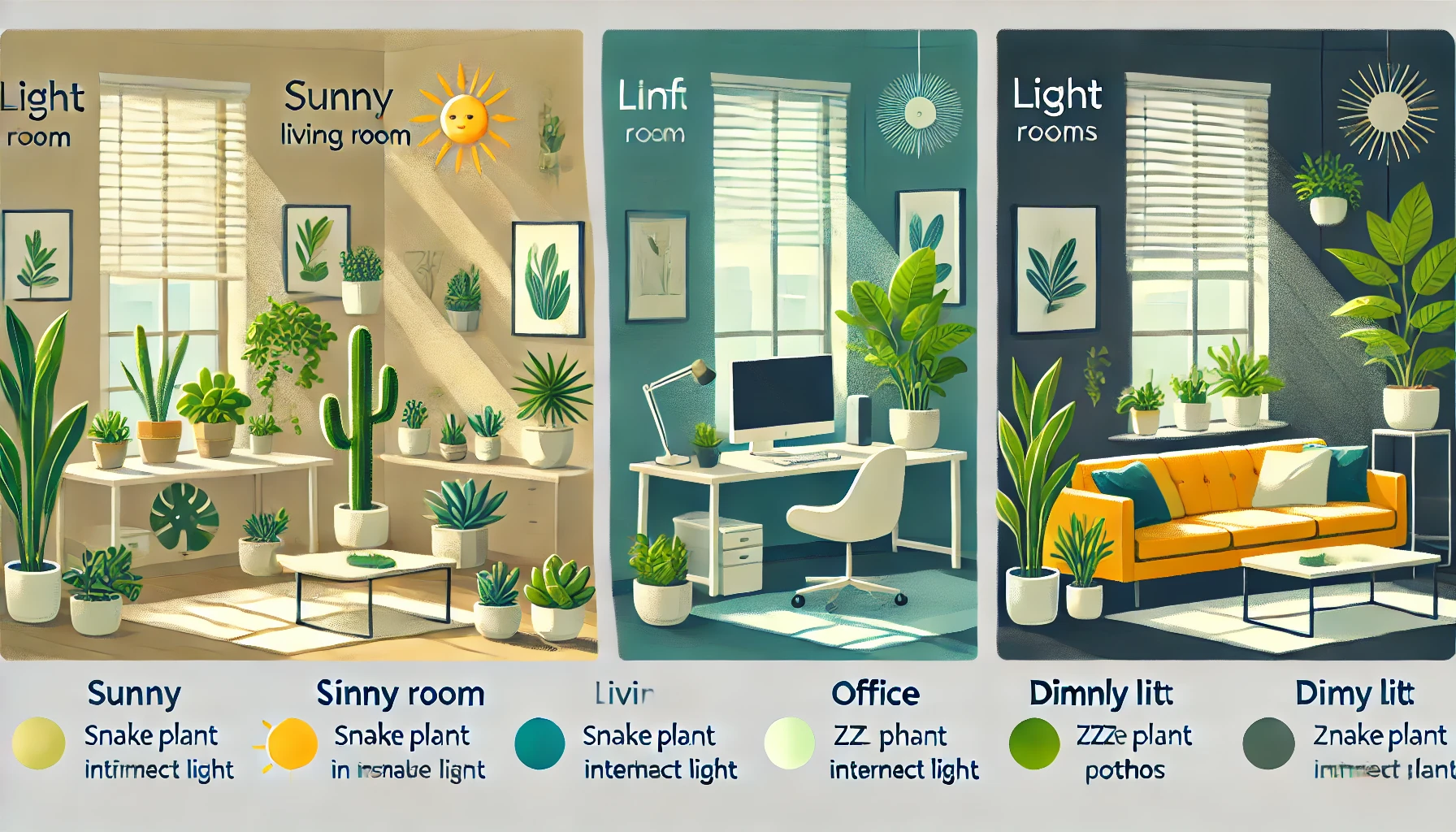
Space & Size 🏡
Consider how much space you have available before choosing a plant.
- Smaller spaces: Compact plants like pothos, snake plants, or air plants 🪴 are great for tight spots like desks or shelves.
- Larger rooms: For spacious rooms, try statement plants like monstera 🌱 or fiddle leaf figs for a dramatic effect.
By understanding these factors, you can make sure your plants will be happy and healthy in their new home!
Choosing Plants Based on Room Function 🏠🌿
Each room in your home serves a different purpose, and the plants you choose can enhance both the function and vibe of the space. Let’s explore the best plant options based on the function of your rooms:
Living Room 🌟
Your living room is the heart of your home, often used for relaxation, entertainment, and family gatherings. Choose plants that add ambiance and purify the air.
- Best plants: Snake plants, rubber plants, and fiddle leaf figs make bold statements and thrive in bright, indirect light.
- Why: These plants help clean the air, improve room aesthetics, and can grow tall to fill larger spaces.
Bedroom 🛏️
For the bedroom, you want plants that promote relaxation and improve air quality, helping you sleep better.
- Best plants: Lavender, peace lilies, and aloe vera 🌸 are great for bedrooms.
- Why: Lavender helps with relaxation, while peace lilies purify the air and aloe vera can have healing properties. These plants also thrive in low to medium light.
Kitchen 🍽️
Kitchens are warm, humid environments, making them ideal for plants that enjoy these conditions. Plus, fresh herbs can add a fun and functional touch to your space!
- Best plants: Herbs (basil, mint, rosemary), spider plants, and pothos 🍃.
- Why: Herbs thrive in the kitchen’s warmth, while spider plants and pothos can handle the humidity and help purify the air.
Bathroom 🛁
Bathrooms tend to have high humidity, making them perfect for plants that thrive in moist environments.
- Best plants: Ferns, peace lilies, and orchids 🌿.
- Why: These plants love humidity and low light, making them ideal for bathroom spaces. Plus, they can create a calming, spa-like atmosphere.
Office 🖥️
Your workspace should inspire focus and productivity. Plants that are low maintenance and clean the air are perfect for this room.
- Best plants: Succulents, snake plants, and pothos 🌱.
- Why: These plants are easy to care for, improve air quality, and create a calm atmosphere, making them great choices for your office.
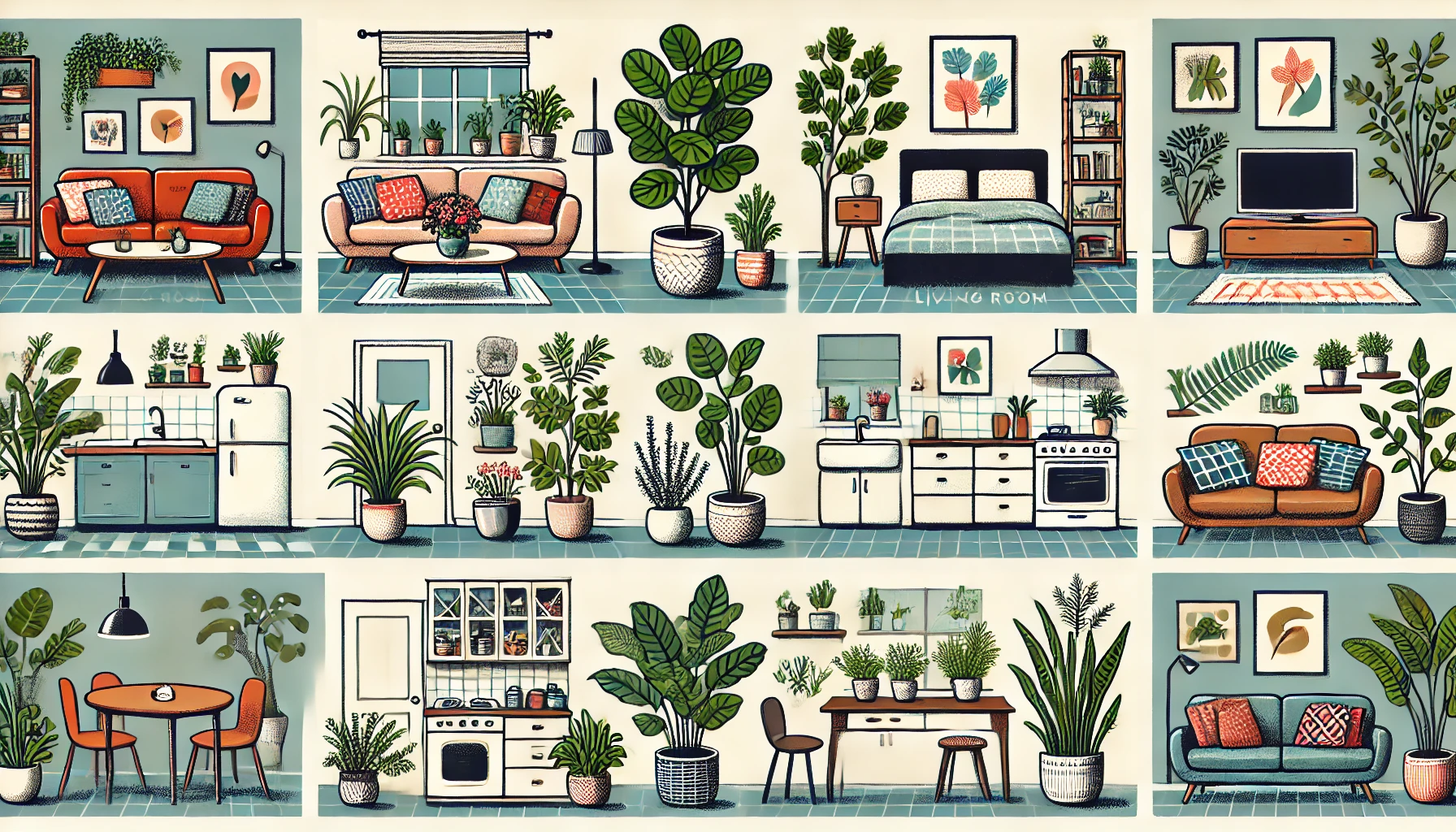
By choosing the right plants for each room, you’ll not only enhance the functionality of the space but also boost the overall atmosphere of your home. 🌿✨
Aesthetic Considerations: Matching Plants to Your Home Décor 🌸🏡
Plants are not only great for your health and environment, but they also play a significant role in enhancing your home’s aesthetic. When choosing the right plant for each room, it’s important to consider how the plants will complement your existing décor. Let’s dive into how to pick plants that match your style and elevate your space!
Color Coordination 🎨
The right plant can be a beautiful pop of color that complements your room’s palette.
- Greenery on neutral backgrounds: If your room has neutral tones like white, beige, or gray, vibrant green plants (like snake plants or ZZ plants) can bring a refreshing burst of life without clashing with your décor.
- Complementing bold colors: For rooms with bold colors, consider plants with colorful leaves or flowers, like coleus or croton 🌿, which can add an extra layer of richness to the space.
Plant Styles 🌱
The style of your room should guide your choice of plants. Different plants suit different aesthetics, whether you’re going for minimalist, boho, or tropical vibes.
- Minimalist: Opt for sleek, low-maintenance plants like succulents or snake plants 🪴 in simple, modern pots. Their clean lines match perfectly with minimalist furniture and décor.
- Boho: For a cozy, eclectic feel, go for hanging plants like string of pearls or ivy. Their trailing vines add a relaxed, free-spirited vibe.
- Tropical: To create a lush, jungle-like atmosphere, choose large, dramatic plants like monstera 🌿 or palm trees for a bold, tropical look.
Pot Choices 🏺
The right pot can make or break your plant’s look. Consider both style and functionality when choosing pots.
- Modern & sleek: Choose simple, geometric pots in neutral tones like black, white, or concrete for a minimalist style.
- Rustic or vintage: Opt for terracotta pots or wooden planters for a more earthy, rustic vibe.
- Bohemian: Woven baskets or colorful ceramic pots pair beautifully with plants like pothos or spider plants 🧺.
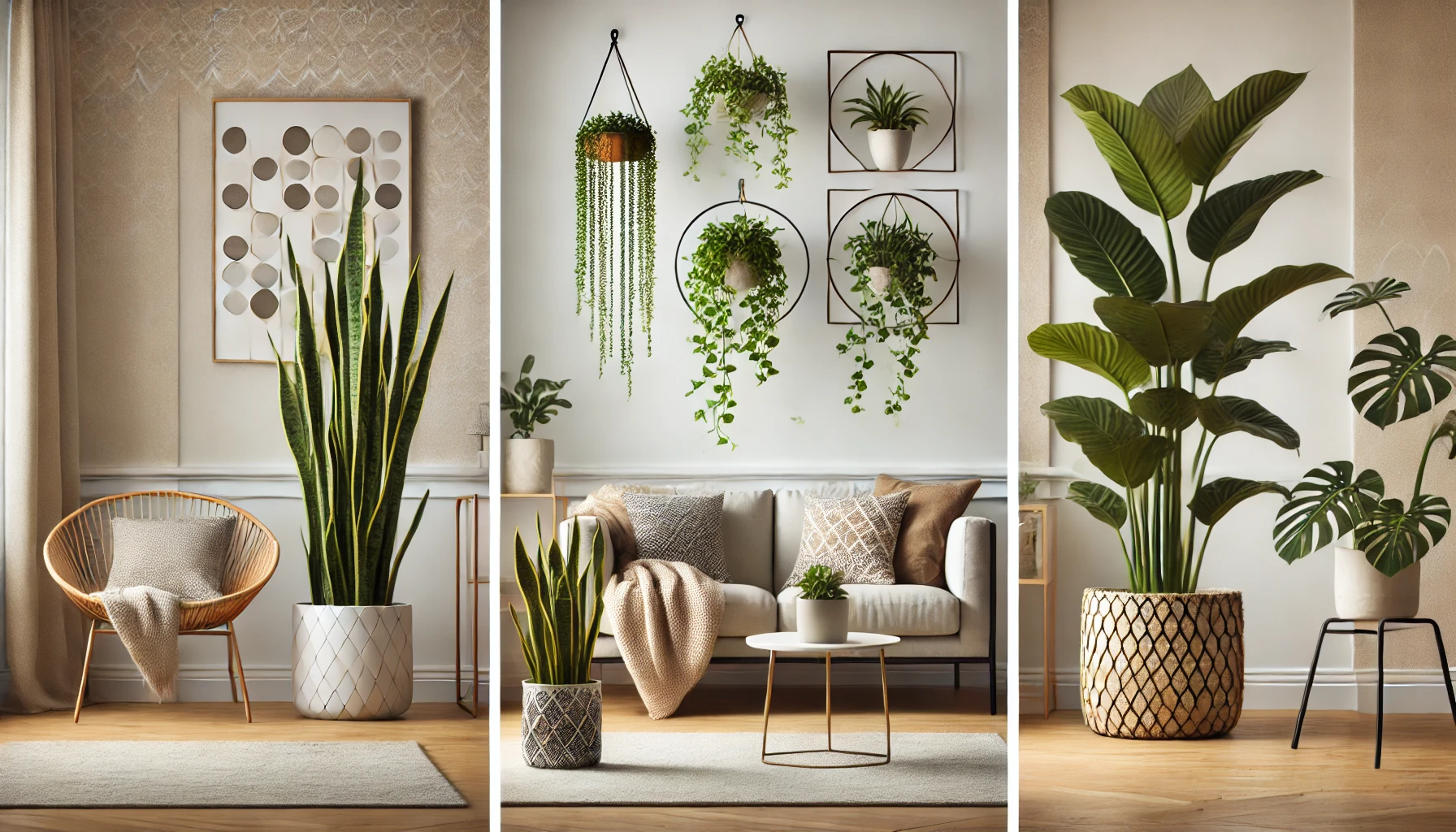
Size and Scale 📏
The size of your plant should fit the scale of the room and its furniture.
- Small spaces: Smaller plants like air plants, succulents, or cactus in cute pots can sit on windowsills or shelves without overwhelming the space.
- Large spaces: Bigger rooms or corners may benefit from larger plants, like a fiddle leaf fig or a rubber plant, which can become a statement piece in the room.
By thoughtfully matching plants with your room’s style and décor, you’ll create a harmonious and welcoming atmosphere while also highlighting your unique interior design. 🌿✨
Plant Care Requirements: Low Maintenance vs. High Maintenance 🌿🌱
When choosing the right plant for each room, it’s essential to consider how much care and attention each plant needs. Some plants thrive with minimal effort, while others require a bit more dedication. Understanding the difference between low-maintenance and high-maintenance plants will help you make the best choice for your lifestyle.
Low Maintenance Plants 🪴
If you’re new to plants or just want something that doesn’t require constant attention, low-maintenance plants are the way to go. These plants can thrive with basic care, making them perfect for busy individuals or beginner plant owners.
Best choices:
- Snake Plant (Sansevieria): Thrives in low light and doesn’t need frequent watering. Perfect for living rooms or offices.
- ZZ Plant: Another low-light lover that doesn’t need a lot of water, making it ideal for rooms that are less humid, like bedrooms.
- Pothos: A hardy, easy-to-grow vine that can handle varying light conditions and infrequent watering. Great for kitchens or bathrooms.
- Succulents: Succulents like Aloe Vera or Echeveria are perfect for dry, sunny rooms and require minimal watering.
Why they’re great
These plants require little care, meaning less stress for you! Just a little watering, the right lighting, and they’ll thrive.
High Maintenance Plants 🌸
If you enjoy tending to your plants and want to challenge yourself, high-maintenance plants are rewarding but require more attention. These plants often need specific conditions, like consistent moisture, extra humidity, or regular feeding.
Best choices:
- Fiddle Leaf Fig: Known for its large, dramatic leaves, this plant needs bright light and regular watering. It also needs the right humidity to prevent its leaves from browning.
- Orchids: Stunning blooms, but they require careful watering and humidity control. Best placed in bathrooms or kitchens where the air is more humid.
- Calathea: Calatheas love indirect light and need consistent moisture to keep their beautiful patterned leaves from wilting. They thrive in rooms with a bit more humidity.
Why they’re rewarding
High-maintenance plants offer stunning beauty and character, but they’ll need regular attention to stay healthy. With the right care, they can become show-stopping centerpieces in your home.
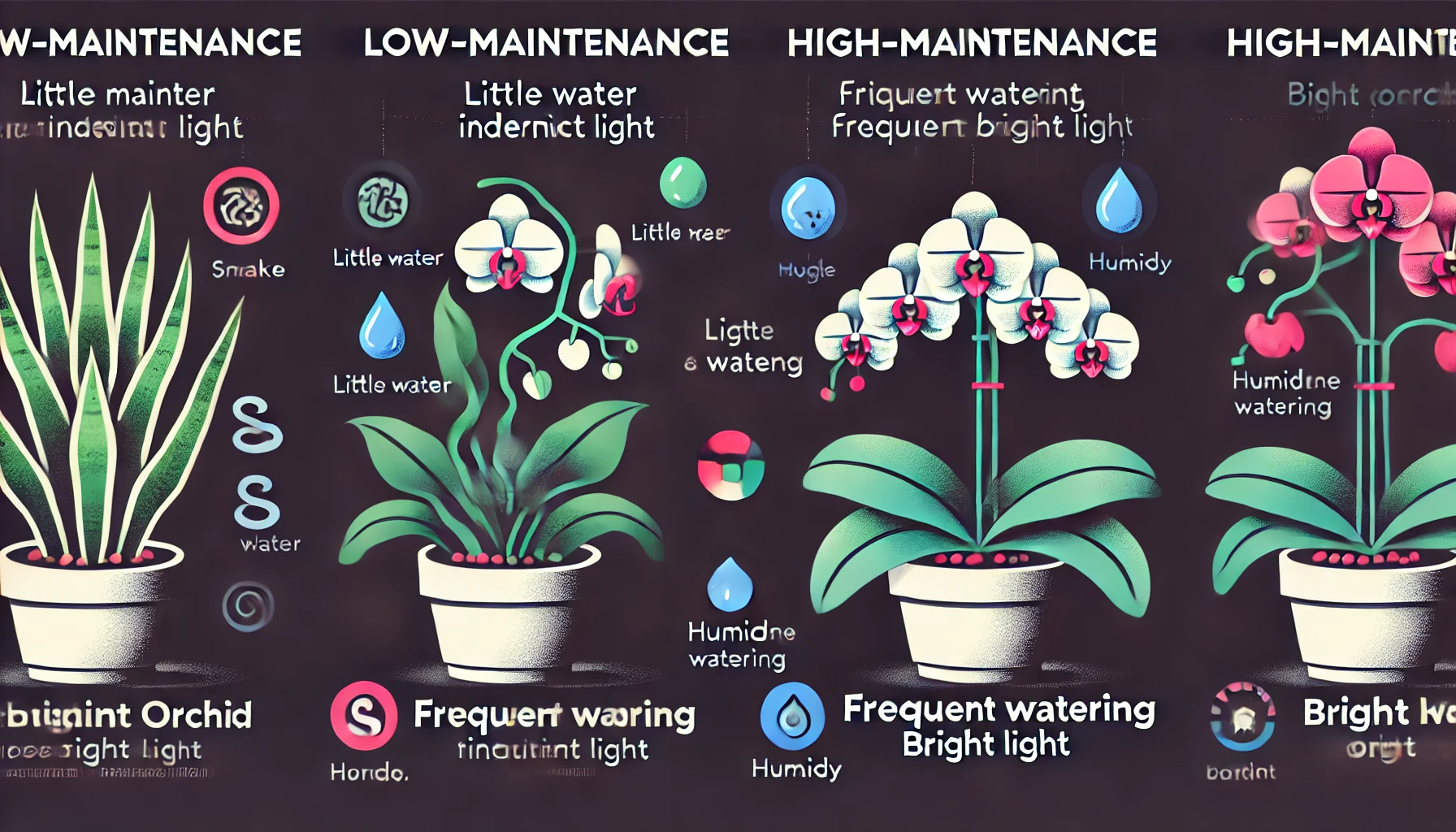
Which One to Choose?
- For busy lifestyles: If you’re often on the go or want a plant that doesn’t need much fuss, opt for low-maintenance varieties like snake plants or succulents.
- For plant enthusiasts: If you have the time and love tending to your greenery, high-maintenance plants like fiddle leaf figs or orchids will reward you with their beauty.
By understanding your commitment level, you’ll be able to choose plants that match your lifestyle and enjoy the benefits of indoor greenery without feeling overwhelmed. 🌱✨
Common Mistakes to Avoid When Choosing Plants 🚫🌿
When it comes to choosing the right plant for each room, even seasoned plant owners can make mistakes that hinder plant health or aesthetics. Here are some common pitfalls to avoid, ensuring your plants thrive and bring joy to your home.
Overwatering or Underwatering 💧
One of the most common plant care mistakes is not getting the watering right.
- Overwatering: Many plants die from root rot due to too much water. Always check if the top inch of soil is dry before watering, and make sure your pots have good drainage.
- Underwatering: On the flip side, neglecting your plants and forgetting to water them can lead to wilting or dry leaves. Use a watering schedule to avoid this.
Tip: Some low-maintenance plants like snake plants or succulents can go longer without water, while others, like peace lilies, prefer consistently moist soil.
Choosing Plants that Don’t Match the Room’s Light 🌞
Each plant has its preferred lighting conditions, and putting a plant in a room with the wrong type of light can cause it to struggle.
- Bright light plants (like cactus or succulents) need direct sunlight, while low light plants (like ZZ plants or pothos) will thrive in shaded areas.
- Solution: Before buying a plant, assess the lighting in each room. Consider window orientation and whether the room has direct sunlight or just indirect light.
Not Considering Plant Size as it Grows 📏
Many plants start small but can grow significantly larger over time. Choosing a plant without thinking about its full-grown size can result in overcrowded rooms or plants that outgrow their space.
- Solution: Do your research! Plants like fiddle leaf figs and monstera can grow quite large, so make sure you have enough room for them to thrive as they mature.
Ignoring Temperature and Humidity Needs 🌡️
Different plants have different temperature and humidity needs. Ignoring this can cause stress for your plants.
- Tropical plants like calatheas need humidity and warm temperatures, while succulents prefer dry, cool conditions.
- Solution: Make sure your plants’ needs match the conditions of the room. Consider using a humidifier for moisture-loving plants in dry areas or placing tropical plants in more humid rooms like the bathroom.
Not Factoring in Plant Care Requirements 🧑🌾
Sometimes, we fall in love with a plant because it looks beautiful, but its care requirements might not suit our lifestyle.
- Solution: Be honest with yourself about how much time you can dedicate to plant care. If you don’t have a green thumb, opt for low-maintenance plants like pothos or snake plants. For plant lovers who enjoy the care routine, high-maintenance plants like orchids or fiddle leaf figs might be perfect!
Overcrowding Your Space 🪴
It’s easy to get carried away with the number of plants you bring into your home, but too many plants can create a cluttered feel.
- Solution: Choose plants that complement each other in terms of size and style. Leave enough space for each plant to thrive and to avoid overwhelming your room.
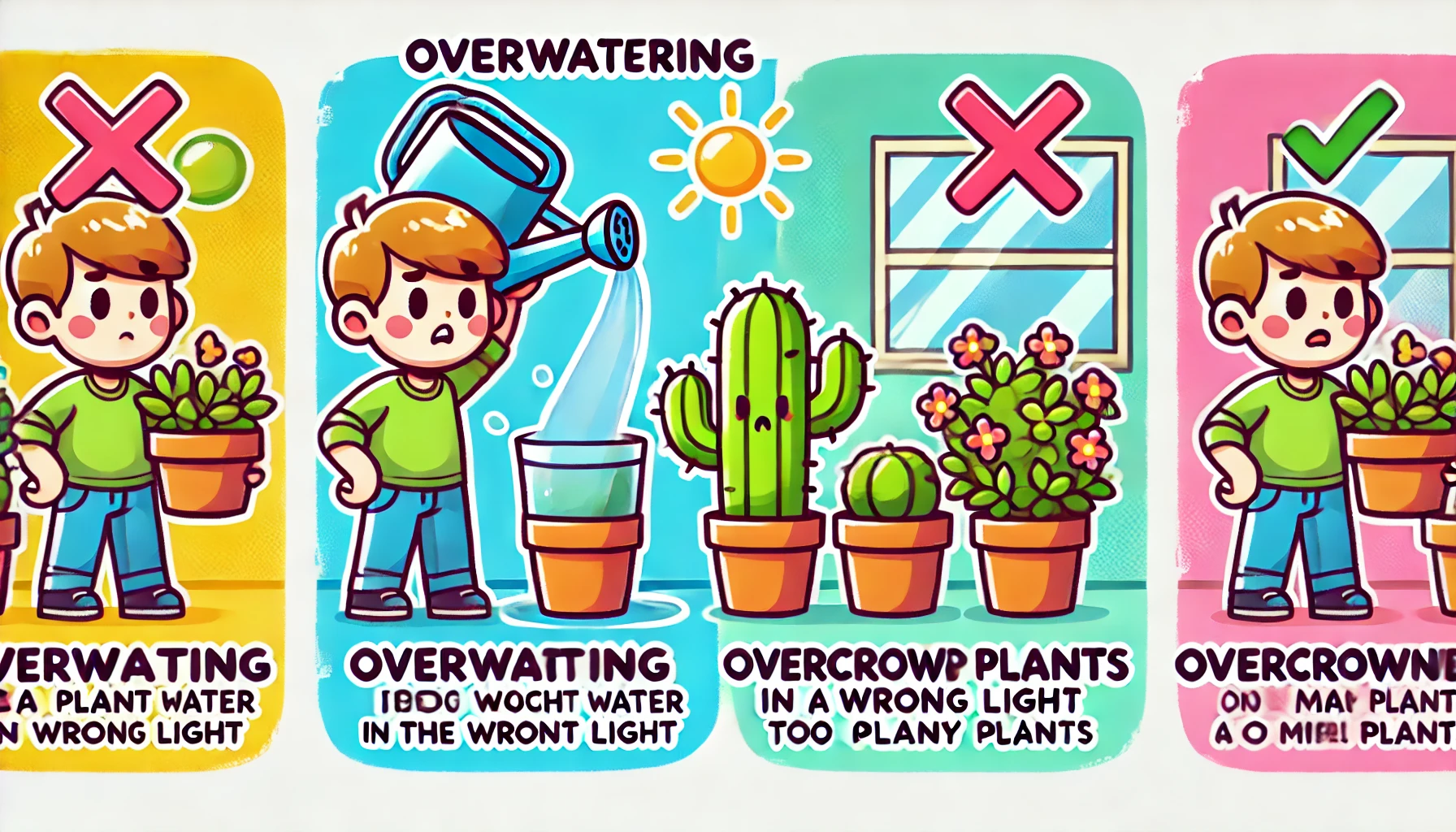
By avoiding these common mistakes, you’ll be well on your way to creating a thriving indoor garden that adds beauty, air quality, and serenity to your home! 🌱✨
Final Thought
Choosing the right plant for each room is more than just about adding greenery—it’s about creating an environment that enhances both your home’s aesthetic and your well-being. By understanding room factors like lighting, temperature, and space, and by selecting plants that match your décor and lifestyle, you can build a flourishing indoor garden that’s both beautiful and easy to maintain.
Remember, the best plant for your space is one that thrives in the conditions you can provide. Whether you opt for low-maintenance plants like succulents or embrace the challenge of high-maintenance beauties like orchids, every plant brings a little more life to your home. Avoid common mistakes by researching care requirements, considering plant size, and keeping your room’s needs in mind.
With the right plants, you can enjoy a fresh, inviting, and calming atmosphere throughout your home. Happy planting! 🌱🌸
Frequently Asked Questions (FAQ)
How do I choose the best plants for different rooms in my home?
Consider light levels, humidity, and space availability to match plants with the right environment.
What are the best plants for low-light rooms?
Snake plants, ZZ plants, and pothos thrive in low-light conditions with minimal care.
Which plants are best for improving air quality indoors?
Peace lilies, spider plants, and rubber plants help filter toxins and improve air quality.
Can I keep plants in my bathroom with high humidity?
Yes, ferns, orchids, and pothos thrive in humid environments like bathrooms.
What are good plant choices for a bright and sunny kitchen?
Herbs like basil, rosemary, and mint grow well in bright kitchen windows.
Which plants are best for a bedroom to promote relaxation?
Lavender, snake plants, and aloe vera improve air quality and create a calming atmosphere.
What are pet-friendly plants for a home with cats or dogs?
Calatheas, areca palms, and parlor palms are non-toxic and safe for pets.
Can I place plants in windowless rooms?
Yes, low-light plants like ZZ plants and snake plants can survive with artificial grow lights.
